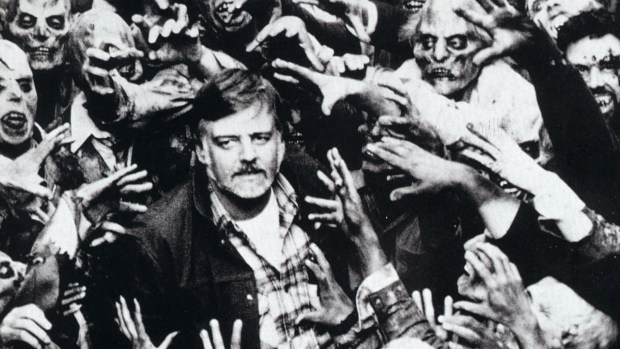I’m sure many of you are fans of the Walking Dead¸
whether in the medium of a comic book, novel, computer game or TV series – it’s
truly impossible to avoid… and why would you want to? In any form it’s become
one of my favourite Zombie worlds since George Romero gave birth to the modern
version.
 |
| Who wants ice cream? Daddy's buying ice cream! |
Being a scientist I’m interested in what Zombieism would be
like in real life, and what elements we see in fiction would actually work in
reality. The Walking Dead has thrown up a few brain teasing questions that I’m
keen to answer. So in today’s ZomBlog I’m going to investigate their version of
Zombieism, specifically trying to figure out these two puzzles…
How is the disease
being transmitted?
And.
Whether their
claim that everyone has the disease, but not everyone has shown symptoms, is
really possible?
 |
| Why won't you just love me? |
Whether intentional or not, Walking Dead makes the clever
decision of not explicitly telling us what is causing the disease, making it
more fun to theorise on.
"Internally, we don't know
where the zombie outbreak started, how to cure it, anything like that,"
– Glen Mazzara, Show Runner, Walking Dead (TV Series)
“...the rule is: WHATEVER it is
that causes the zombies, is something everyone already has. If you stub your
toe, get an infection and die ... you turn into a zombie." – Robert Kirkman, Creator,
Walking Dead
In the TV series even a CDC disease specialist whose been
studying the outbreak for months hasn’t been able to figure out the causative
agent.
“It could be microbial, viral,
parasitic, fungal…”
– Dr. Edwin Jenner, Walking Dead, Season 1
Episode 6
 |
| Animal, vegetable, mineral ... wait ... what was the question? |
From observation we can make some assumptions about its transmission:
The disease seems to spread through saliva. People contract
it after being bitten by infected people. This is much like Rabies. A Rabies
infected animal has the virus in its nerves and saliva, and can transmit it to
a human through biting. In rarer cases, the animal can spread the virus when
its saliva comes in contact with a person's mucous membranes (moist skin
surfaces, like the mouth or inner eyelids), or broken skin such as a cut,
scratch, bruise or open wound.
In Walking Dead, no one appears to have been infected from
indirect contact. For example, the survivors must spend a massive amount of
time off camera cleaning up the biological debris left by each action scene.
This would inevitably include a few litres of Walker drool. Yet never has a
character turned after embarking upon a heavy session of mopping, when perhaps,
in the rarest of cases they should. (Exciting idea for Season 4? No expensive make-up
or effects, just a mop and 250ml of dirty drool!?!)
Rabies has never been found in blood, perhaps it’s the same
with the Walking Dead Zombie disease. This would explain why, despite the
characters flip-flopping between being careful to avoid contact with Zombie
blood and getting splashed on like a kid at Sea World, they don’t get the
illness.
 |
| I told you, this episode we stay clean of Walker bits, next season we'll be like kids in a fountain. Visualise the fountain with me Rick. Visualise. |
Alongside the saliva based transmission we also get a
shocking revelation from the only bona fide medical expert we meet in the TV
series, shortly before killing himself, when he utters the terrifying line, “every
survivor is infected.”
How can everyone be infected but not turn?
An interesting comparison is latent tuberculosis infection.
Tuberculosis is caused by bacteria called Mycobacterium tuberculosis.
Some people who are infected by it do not develop the active illness. It simply
remains inactive and stays that way in the majority of cases – this is known as
latent tuberculosis infection. For a small percentage of people it can
eventually become active for a variety of reasons; if their immune system is
damaged or compromised, if they become malnourished, or simply when they become
older. So our Walking Dead characters may have latent Zombieism infection. A
major biological event, such as a severe trauma, or being near death, may be
what is activating it.
 |
| We've really got to stop letting the Daleks make these posters... |
We’ve managed to answer both of our questions today. How is
the Walking Dead Zombie disease being spread? It could be like Rabies, in the
saliva of the infected Walkers. This would explain why getting covered in blood
and guts doesn’t turn anyone. But realistically the characters should be
equally afraid of being licked by a Walker as being bitten by one.
Finally, we discovered that it is possible for us humans to
be infected by a disease that lies inactive, waiting for certain conditions to
get it going. A terrifying thought, I’ll not sleep tonight!
I do hope you enjoyed this entry, and if any of you out
there want to know anything about the real science behind Zombies, do send your
questions to info@zombiescience.co.uk, post them in our Book of Faces (www.facebook.com/zombiescience)
or get in touch on our website www.zombiescience.co.uk.
Want to know whether cutting off a limb after being bitten would prevent you becoming a Zombie? Or would a pregnant woman who was bitten give birth to a Zombie Baby? Read other ZomBlog's to find out!
Stay Frosty,
Doctor Austin
Doctor Austin ZITS BSz MSz DPep, is a Theoretical
Zombiologist and Head of the Zombie Institute for Theoretical Studies at the
University of Glasgow, Scotland UK.



